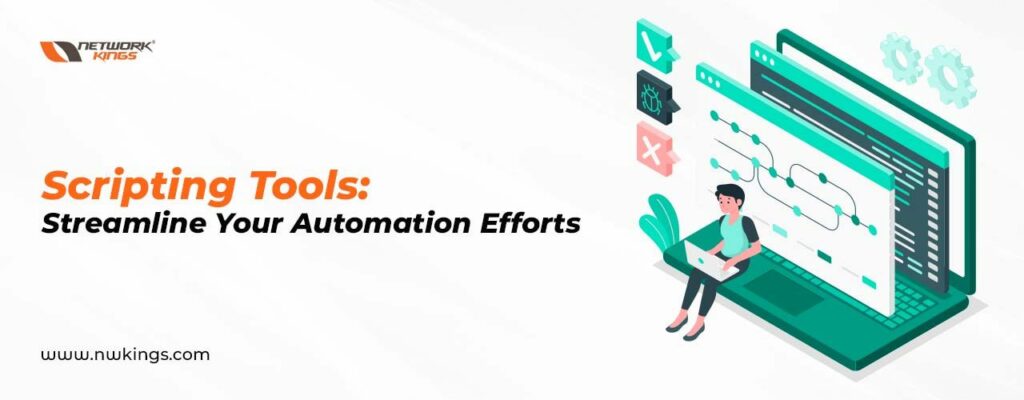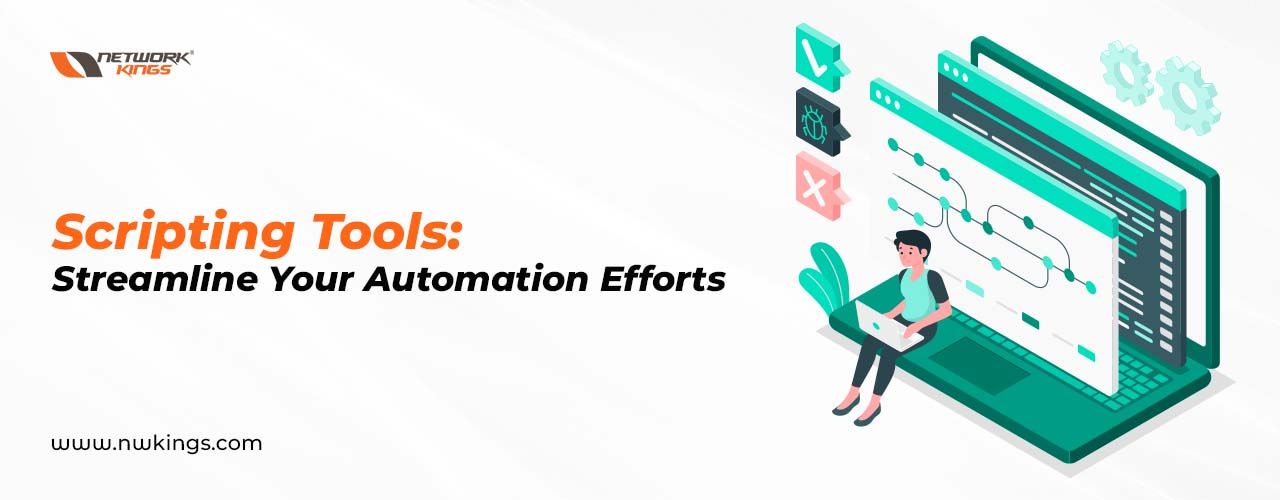
In today’s fast-paced digital world, scripting tools have become essential for automating tasks and improving efficiency. Whether you’re a developer, sysadmin, or IT professional, scripting tools can save you countless hours of manual work and streamline your workflows.
Scripting languages are a kind of programming language where the instructions are written for a time-frame environment to conduct new functions to applications and combine or share complex systems and other programming languages. You have likely heard of PHP, Python, JavaScript, and jQuery.
Scripting tools have become the spine of modern software development, changing standard practices into efficient, elegant, and quality-driven processes in both DevOps and testing. Their impact is key in executing quicker, more dependable releases and nurturing a culture of constant progress.
In this blog, we will explore the world of scripting tools, and their benefits, and provide a curated list of the top tools available across various domains.
What are Scripting Tools?
Scripting tools are software applications or frameworks that allow users to automate repetitive tasks by writing scripts. These scripts are essentially sets of instructions that the tool executes, eliminating the need for manual intervention. Scripting tools are commonly used in software development, system administration, data analysis, and many other domains.
What are the Popular Scripting Tools?
Here’s a probe of different scripting tools across distinct categories:
Shell Scripting Tools:
- Bash: Default shell for numerous Linux allocations, powerful scripting language for automating tasks in Unix/Linux environments.
- Zsh: An illustrative version of the Bourne shell (sh) with numerous features for interactive use and scripting.
- Fish: User-friendly shell scripting language with auto-suggestions and a clean syntax.
Automation Scripting Tools:
- Ansible: Automates IT tasks like configuration management, application deployment, and orchestration.
- Puppet: Configuration management tool for automating the provisioning, configuration, and management of servers.
- Chef: Configuration management tool focusing on infrastructure automation.
Testing Scripting Tools:
- Selenium: A popular framework for automating web browser testing, supporting multiple programming languages.
- JUnit: Java-based testing framework for writing and running repeatable automated tests.
- Cypress: End-to-end testing framework for web applications with features for simulating user interactions.
DevOps Scripting Tools:
- Docker CLI: Commands and scripting for managing Docker containers and images.
- Terraform: Infrastructure as Code (IaC) tool for building, changing, and versioning infrastructure efficiently.
- Jenkins DSL: Groovy-based scripting for defining Jenkins jobs as code.
PowerShell Scripting Tools (Windows):
- PowerShell Core: Cross-platform scripting language supporting automation and configuration across various systems.
- PowerShell ISE: Integrated scripting environment for writing and testing PowerShell scripts.
- PowerShell Gallery: Repository for sharing and discovering PowerShell modules.
Cross-Platform Scripting Tools:
- Python: Versatile, high-level scripting language used for automation, web development, and more.
- Ruby: Dynamic, object-oriented scripting language with a focus on simplicity and productivity.
- Perl: Powerful scripting language with strong text processing capabilities.
Windows Scripting Tools:
- VBScript: Microsoft’s scripting language for automating tasks within Windows applications.
- AutoIt: Scripting language designed for automating the Windows GUI and general scripting.
- Windows PowerShell: Command-line shell and scripting language built for Windows environments.
Bash Scripting Tools (Unix/Linux):
- AWK: Text processing language for pattern scanning and processing.
- SED: Stream editor for filtering and transforming text, often used in conjunction with shell scripts.
- GNU Parallel: Command-line tool for executing commands in parallel, speeding up script execution.
Every kind of scripting tool serves precise needs, delivering various functionalities across distinct operating systems, making them valuable in automating, managing, and testing different parts of software development and system administration.
Use Cases for Scripting Tools
1. System Administration
Scripting tools like Bash, PowerShell, and Python are invaluable for system administrators. They can automate tasks such as user management, log analysis, backups, and software installations. With scripting tools, sysadmins can efficiently manage large-scale infrastructures, reducing manual effort and minimizing errors.
2. Software Development
Scripting tools play a crucial role in software development pipelines. They can automate building, testing, deploying, and monitoring applications. Continuous integration/delivery (CI/CD) pipelines often rely on scripting tools like Ansible or Puppet to automate various stages of the development lifecycle.
3. Data Analysis
Scripting tools like Python are widely used in data analysis and data science. With libraries such as NumPy, Pandas, and Matplotlib, Python enables professionals to perform complex data manipulations, statistical analysis, and visualization. Automation through scripting tools saves time when working with large datasets or performing repetitive analysis tasks.
4. Network Management
Networking professionals often utilize scripting tools like Python or PowerShell to automate network device configurations, monitor network performance, and generate reports. By automating network management tasks, IT teams can maintain consistency across devices and respond quickly to changes or incidents.
What are the Benefits of Shell Scripting in DevOps?
Shell scripting plays a crucial role in DevOps practices, offering several benefits that streamline processes, automate tasks, and enhance general efficiency. Here are the basic advantages of shell scripting in DevOps:
- Automation of Repetitive Tasks: Shell scripts automate routine tasks, such as file manipulation, system configurations, and log management. This automation reduces manual intervention, saving time and decreasing human error.
- Workflow Streamlining: DevOps practices emphasize continuous integration and deployment (CI/CD). Shell scripting allows the creation of automated workflows, allowing seamless integration, testing, and deployment processes.
- Infrastructure Provisioning: In modern DevOps, infrastructure as code (IaC) is critical. Shell scripts help in equipping and configuring infrastructure components, allowing for easy replication and consistency across environments.
- Environment Setup and Configuration: Shell scripts help set up development, testing, and production environments consistently. They configure different tools, libraries, and reliances needed for applications, providing uniformity.
- Task Scheduling and Job Automation: DevOps often affects scheduling jobs and tasks. Shell scripts, along with cron jobs or other schedulers, automate the implementation of tasks at predefined intervals or precise times.
- Enhanced Collaboration: By encapsulating tasks in scripts, DevOps teams accomplish better cooperation. Standardized scripts guarantee that team members comprehend and accomplish tasks uniformly, enabling collaboration across the development and operations teams.
- Rapid Problem Resolution: In troubleshooting or incident response scenarios, shell scripts help in analyzing and fixing issues swiftly. Scripts can automate checks, develop logs, or complete diagnostic routines, aiding in faster problem resolution.
- Cost and Time Efficiency: Shell scripting lessens manual effort, which guides to cost savings and improved productivity. Tasks that could take hours or days manually can be accomplished in minutes through scripted automation.
- Scalability and Flexibility: Shell scripts are flexible and scalable. They can adapt to changes in code, compositions, or mounting conditions, making them appropriate for active and evolving environments.
- Integration with DevOps Tools: Shell scripts blend seamlessly with various DevOps tools and platforms, allowing interaction with version control systems, CI/CD pipelines, cloud services, and more.
How to Choose the Right Scripting Tool?
Choosing the right scripting tool depends on several factors:
Task requirements: Determine the specific tasks you need to automate and choose a tool that best fits those requirements.
Familiarity: Consider your familiarity with different languages or frameworks and choose a tool that aligns with your existing knowledge.
Ecosystem: Assess the availability of libraries, frameworks, and community support for the chosen tool.
Scalability: Evaluate whether the tool can handle the scale of your operations and if it integrates well with other systems or tools in your environment.
Platform compatibility: Ensure that the scripting tool is compatible with your target platform(s), such as Windows, Linux, or macOS.
Conclusion
Mastering scripting tools is a transformative journey that certifies individuals and firms to open unparalleled efficiencies, automation, and innovation across various technical landscapes.
Scripting tools, spanning different types like shell scripting, automation, testing, and more, serve as the spine of modern software development, system administration, and DevOps practices. They suggest an excess of advantages, including automation of repetitious tasks, streamlining workflows, and improving cooperation among teams.
By exploring popular scripting languages like Bash, Python, and PowerShell, as well as automation tools like Ansible and Puppet, professionals can identify the best fit for their specific needs and unlock the full potential of automation in their respective domains.


